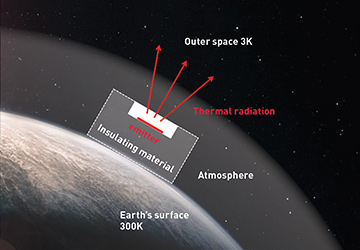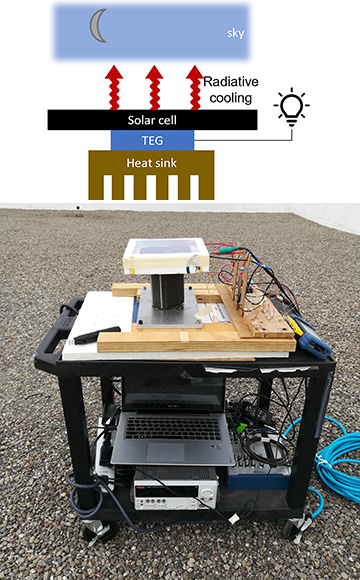![]()
A Stanford University team has prototyped a system that the researchers believe could provide power for nighttime illumination from solar-cell installations in rural areas—without costly, complex battery installations. [Image: Diana Giba / EyeEm / Getty Images]
For many rural and resource-constrained areas lacking direct access to power grids, stand-alone solar installations offer a potential lifeline for daytime electricity. But keeping the lights on at night generally requires battery systems to store energy sopped up by photovoltaic (PV) cells during daylight hours—a factor that adds cost and complexity.
Researchers at Stanford University, USA, headed up by Optica Fellow Shanhui Fan, have their eye on an alternative approach: keeping the electricity running at night by harnessing the heat flow that radiates from Earth after the sun goes down. In a recent study, researchers used such a scheme to pull nighttime electricity from a prototype solar-energy installation at a power density of 50 mW/m2—in a setup cobbled together from off-the-shelf parts (Appl. Phys. Lett., doi: 10.1063/5.0085205).
That’s sufficient, the authors suggest, to make the approach interesting for “nighttime standby lighting” out of the box. And the team believes that, with additional engineering and optimization, the performance could improve, offering the potential for “a continuous renewable power source for both day and night time in off-grid locations.”
Radiative cooling
Thermodynamically, the approach demonstrated by the Stanford team rests on the fact that Earth continuously radiates heat energy into outer space, owing to the atmosphere’s transparency in a mid-infrared wavelength window from around 8 to 13 nm. Such heat flow into the cold universe, from Earth and from objects on it, occurs during both day and night.

Earth continually radiates heat into space through a mid-infrared wavelength window in the atmosphere. [Image: OPN, November 2019]
That fact has led to work, both by Fan’s group and other teams, to explore materials and systems that could enable energy-efficient “radiative cooling” to supplement or even replace conventional air-conditioning units (see “Radiative Cooling: Harvesting the Coldness of the Universe,” OPN, November 2019). A number of researchers have also suggested that heat flow from Earth—acting as a sort of “negative illumination”—could, in principle, directly drive electricity from PV cells at night. Such schemes, however, would require PVs with band gaps that operate in thermal wavelengths, which isn’t in the cards for the silicon-based solar cells that are widely used today.
Leveraging TEGs
Fan’s team is experimenting with a different idea—one that pairs a conventional silicon PV cell with a thermo-electric power generator (TEG) in a stacked array.
TEGs are devices that convert heat flow directly into electric energy. In previous work, Fan’s team had shown that such a device, placed beneath a sky-facing, radiatively cooling, non-PV black emitter, could produce nighttime power at a density of 25 mW/m2 as the simple emitter cooled at night, causing heat to be drawn through the TEG and there converted into electrical energy. A subsequent study concluded that such a setup, systematically optimized, might churn out power at a density greater than 2 W/m2.
Hardware hacking

A schematic of the system (top), and the built prototype on a Stanford rooftop (bottom). As the PV panel cools at night, the temperature differential with the ground causes radiant heat to flow up through the thermo-electric generator (TEG), creating electric current. [Image: S. Assawaworrarit]
What, the Stanford group wondered, might happen if the role of the radiatively cooling emitter in that scheme were filled not by a simple black material, but by an SiO2-encapsulated conventional PV cell? To get at an answer, Fan and coauthors Sid Assawaworrarit and Zunaid Omair did a little hardware hacking.
The team began with a commercially available 153-cm2 monocrystalline solar cell, and placed it on an aluminum sheet to enhance thermal conduction. Beneath the aluminum sheet, the researchers attached an off-the-shelf TEG module—which, in turn, they placed on top of a heat sink salvaged from an old personal computer. The heat sink offered a low-thermal-resistance path between for ambient heat from Earth to flow up through the TEG. The team also slathered silicone thermal grease onto each interface to smooth the heat flow between the components.
In principle, during the night, as the PV cell cools down after daytime operation, the temperature difference between the PV and ground should draw heat up through the TEG, generating electricity. As a bonus, the system should also work in reverse: After sunrise, as the PV cell heats up to temperatures above the ambient, the temperature differential should push heat down through the TEG to the ground, again generating voltage and supplementing the daytime power produced by the PV cell.
In experiments on a Stanford rooftop in October 2021, the team found that the combined system with the 153-cm2 solar cell and TEG could produce as much as 0.7 mW of sustained nighttime power, equivalent to a power density of 50 mW/m2. During the day, the TEG added around 20 mW to the solar cell’s power output, or 1.3 W/m2, at noon, around 1% of the power generated by the PV itself during that time.
Optimizations ahead?
While the tested prototype is inexpensive and taps easily available parts, the actual nighttime power densities in this simple demonstration seem unlikely to provide a sustained solution to nighttime illumination in rural and resource-poor areas. Even efficient electric lighting at night needs at least a few watts of power. Scaling up the prototype device to those levels using existing technology would thus presumably require a PV area on the order of around 20 m2.
But the Stanford team believes that, with a bit of optimization, this could be a solvable problem. In an email to OPN, Fan pointed out that, in the prototype, “we did not modify anything about the solar cell”; the system efficiency could well be improved by optimizing the solar cell’s infrared emissivity through modifications to its encapsulating layers. Another tweak could be improvements in the system’s thermal engineering, such as better-optimized contact between the PV cell and the TEG.
With these and other mods, Fan says, it should, in principle, be possible “to get the performance of the solar-cell device to reach what we have done for general emitters.” And, he notes, the widespread installation of solar cells could make adding in a TEG an interesting way to provide “more widely available nighttime power sources.”
